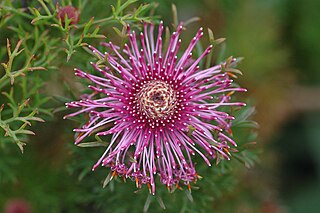
Isopogon formosus, commonly known as rose coneflower, is a species of flowering plant in the family Proteaceae and is endemic to the south-west of Western Australia. It is a shrub with divided leaves with cylindrical segments, and spherical to oval heads of pink or red flowers.

Banksia cirsioides is a species of shrub that is endemic to Western Australia. It has pinnatisect leaves with between six and ten lobes on each side and hairy heads of yellow and pink flowers.

Banksia hewardiana is a species of openly branched shrub that is endemic to Western Australia. It has linear, serrated leaves with sharply pointed teeth, head of up to sixty lemon-yellow flowers and oblong follicles.

Banksia horrida, commonly known as prickly dryandra, is a species of shrub that is endemic to Western Australia. It has hairy stems, linear, pinnatifid leaves with sharply pointed teeth on the edges, up to sixty cream-coloured flowers in each head and hairy, egg-shaped follicles.
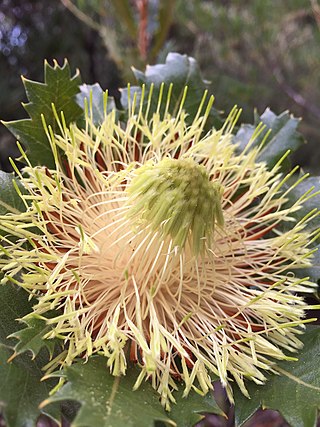
Banksia heliantha, commonly known as oak-leaved dryandra, is a species of shrub that is endemic to Western Australia. It has hairy stems, serrated, egg-shaped to wedge-shaped leaves, golden yellow flowers and partly woolly follicles.

Grevillea obtusifolia, commonly known as obtuse leaved grevillea, is a species of flowering plant in the family Proteaceae and is endemic to the south-west of Western Australia. It is a spreading to dense, prostrate shrub with oblong to narrowly elliptic leaves and clusters of eight to twelve, pink or red flowers.

Grevillea asparagoides is a species of flowering plant in the family Proteaceae and is endemic to the south-west of Western Australia. It is dense, prickly shrub with deeply divided leaves, the end lobes linear and sharply pointed, and pink to reddish flowers with red styles.

Olearia axillaris, commonly known as coastal daisy-bush, coast daisy-bush or coastal daisybush is a species of flowering plant in the family Asteraceae and is endemic to coastal areas of Australia. It is an erect, bushy shrub with densely cottony-hairy branchlets, aromatic, linear to narrowly elliptic or narrowly lance-shaped to egg-shaped leaves with the narrower end towards the base and small white and yellow, daisy-like inflorescences.

Persoonia chamaepeuce, commonly known as the dwarf geebung or heathy geebung, is a plant in the family Proteaceae and is endemic to south-eastern Australia. It is a prostrate shrub with crowded, linear leaves and yellow flowers in the leaf axils.
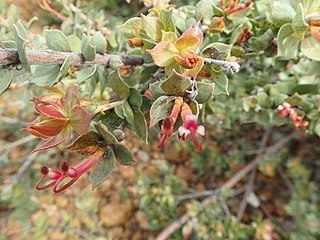
Adenanthos venosus is a species of flowering plant in the family Proteaceae and is endemic to a restricted part of the southwest of Western Australia. It is an openly-branched shrub with clustered egg-shaped leaves and reddish flowers.
Persoonia rudis is a species of flowering plant in the family Proteaceae and is endemic to the south-west of Western Australia. It is an erect shrub with hairy young branchlets, linear leaves, and yellow flowers borne in groups of five to thirty on a rachis 3–100 mm (0.12–3.94 in) that continues to grow after flowering.
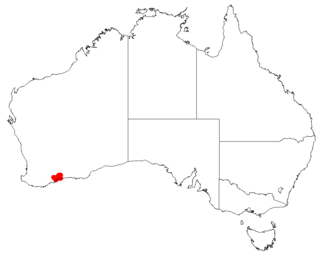
Persoonia dillwynioides, commonly known as Fitzgerald persoonia, is a species of flowering plant in the family Proteaceae and is endemic to a restricted area in the south-west of Western Australia. It is an erect, spreading shrub with smooth bark, linear leaves and bright yellow flowers borne singly or in groups of up to four along a rachis up to 3 mm (0.12 in) long.

Persoonia sulcata is a plant in the family Proteaceae and is endemic to the south-west of Western Australia. It is a small, erect or low spreading shrub with narrow, linear leaves and cylindrical yellow flowers arranged singly or in groups of up to three in leaf axils. It grows in woodland or on rocky slopes and is found in several disjunct populations.
Persoonia hakeiformis is a species of flowering plant in the family Proteaceae and is endemic to the south-west of Western Australia. It is an erect or spreading to low-lying shrub with mostly smooth bark, linear leaves and bright yellow flowers borne in groups of up to sixty along a rachis up to 100 mm (3.9 in) long.

Petrophile carduacea is a species of flowering plant in the family Proteaceae and is endemic to southwestern Western Australia. It is a shrub with deeply toothed leaves, and more or less spherical heads of hairy yellow flowers.

Isopogon scabriusculus is a species of flowering plant in the family Proteaceae and is endemic to southwestern Western Australia. It is a shrub with cylindrical, or narrow flat, sometimes forked leaves, and spherical to oval heads of pink or red flowers.

Isopogon villosus is a species of flowering plant in the family Proteaceae and is endemic to southwestern Western Australia. It is a tufted shrub with cylindrical leaves with twenty-five to thirty-two widely diverging lobes, and oval heads of cream-coloured to yellow flowers.
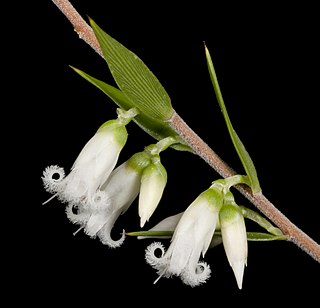
Styphelia conostephioides is a flowering plant in the family Ericaceae and is endemic to the south-west of Western Australia. It is an erect, straggling shrub with lance-shaped leaves with a sharp point on the tip, and white flowers arranged in pairs in leaf axils.

Leucopogon melaleucoides is a species of flowering plant in the heath family Ericaceae and is endemic to eastern Australia. It is an erect, densely branched shrub with lance-shaped or egg-shaped leaves, and white, tube-shaped flowers arranged in spikes in upper leaf axils.

Billardiera variifolia is a species of flowering plant in the family Pittosporaceae and is endemic to the southwest of Western Australia. It is a twining shrub or climber with elliptic adult leaves and groups of deep purple flowers that fade to blue as they age.


















